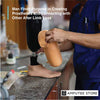Re-Gaining Proprioception with Prosthetic Limbs
The sense of proprioception refers to a person's ability to determine where their limbs are positioned in space without needing to look. This enables you to point where your nose is even when your eyes are closed. Having this sense also makes it easier to balance, move, and manipulate objects.

Researchers at MIT have sought to improve surgical techniques to encourage increased feedback between your nervous system, muscles, and tendons. With this improved feedback loop, the prosthetic limb has better chances of stimulating these areas more naturally, thus offering patients a better sense of proprioception.
MIT's procedure is called AMI (pronounced "Amy") or agonist-antagonist myoneural interface. It seeks to emulate agonist-antagonist muscle pairs' expected behavior, like the biceps and triceps, at the limb loss site. This way, the nerves and muscles surrounding a prosthetic limb can sense and transmit proprioceptive information about the prosthetic limb and even how much force is being applied to it.
According to Hugh Herr, a co-author of the study and an MIT professor of media arts and sciences, AMI dramatically improves patient care. It helps amputees feel proprioceptive positions and forces applied to the prosthetic limb. This would also positively impact how a prosthetic user moves and balances.
Herr and his team first tested the technique on seven rats. They cut muscles and nerves in the rats' hind legs, mimicking an amputation procedure. After a few months, the amputation site healed, and the new muscles were contracting and relaxing in tandem, just like naturally paired muscles would. The healed muscles also successfully sent electrical signals to the brain.
In an interview with Popular Science, Herr said that residual limbs were often cremated and thrown away in the past, wasting the undamaged tissue in that limb. Herr himself is a double below-knee amputee, and his amputation was done the traditional way. After the team's discovery, he said that he could get a revision surgery using muscles from another part of his body to create the agonist-antagonist muscle pairs.
AMI has been used on six human patients so far, and the results have been favorable. The patients reported less pain and more natural function when using conventional prosthetic limbs than patients with traditional amputations. Furthermore, those who used advanced prosthetic limbs enjoyed a greater range of motion and more intuitive control.
Besides restoring a sense of proprioception, AMI surgical technique can also potentially reduce phantom limb pain. Amputees with old or traumatic amputations may avail of this procedure through revision surgery. However, as of publication, AMI can not be performed on patients with vascular diseases, such as diabetes.









































































